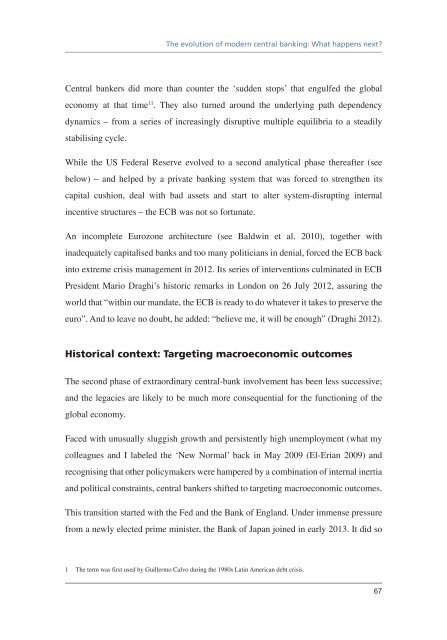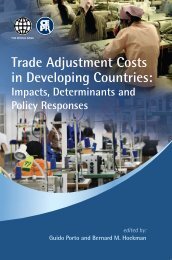Is inflation targeting dead? Central Banking After the Crisis - Vox
Is inflation targeting dead? Central Banking After the Crisis - Vox
Is inflation targeting dead? Central Banking After the Crisis - Vox
You also want an ePaper? Increase the reach of your titles
YUMPU automatically turns print PDFs into web optimized ePapers that Google loves.
The evolution of modern central banking: What happens next?<strong>Central</strong> bankers did more than counter <strong>the</strong> ‘sudden stops’ that engulfed <strong>the</strong> globaleconomy at that time 11 . They also turned around <strong>the</strong> underlying path dependencydynamics – from a series of increasingly disruptive multiple equilibria to a steadilystabilising cycle.While <strong>the</strong> US Federal Reserve evolved to a second analytical phase <strong>the</strong>reafter (seebelow) – and helped by a private banking system that was forced to streng<strong>the</strong>n itscapital cushion, deal with bad assets and start to alter system-disrupting internalincentive structures – <strong>the</strong> ECB was not so fortunate.An incomplete Eurozone architecture (see Baldwin et al. 2010), toge<strong>the</strong>r withinadequately capitalised banks and too many politicians in denial, forced <strong>the</strong> ECB backinto extreme crisis management in 2012. Its series of interventions culminated in ECBPresident Mario Draghi’s historic remarks in London on 26 July 2012, assuring <strong>the</strong>world that “within our mandate, <strong>the</strong> ECB is ready to do whatever it takes to preserve <strong>the</strong>euro”. And to leave no doubt, he added: “believe me, it will be enough” (Draghi 2012).Historical context: Targeting macroeconomic outcomesThe second phase of extraordinary central-bank involvement has been less successive;and <strong>the</strong> legacies are likely to be much more consequential for <strong>the</strong> functioning of <strong>the</strong>global economy.Faced with unusually sluggish growth and persistently high unemployment (what mycolleagues and I labeled <strong>the</strong> ‘New Normal’ back in May 2009 (El-Erian 2009) andrecognising that o<strong>the</strong>r policymakers were hampered by a combination of internal inertiaand political constraints, central bankers shifted to <strong>targeting</strong> macroeconomic outcomes.This transition started with <strong>the</strong> Fed and <strong>the</strong> Bank of England. Under immense pressurefrom a newly elected prime minister, <strong>the</strong> Bank of Japan joined in early 2013. It did so1 The term was first used by Guillermo Calvo during <strong>the</strong> 1980s Latin American debt crisis.67














